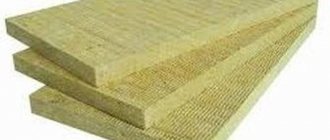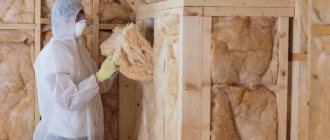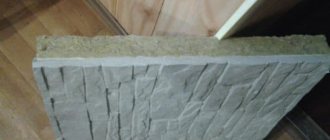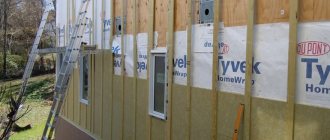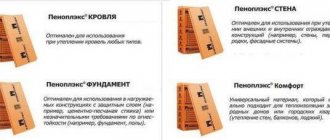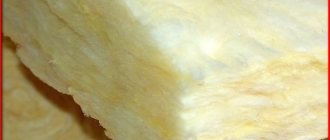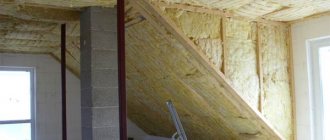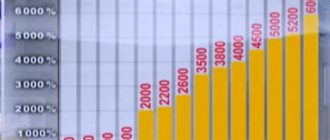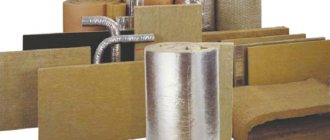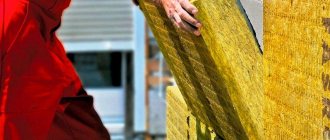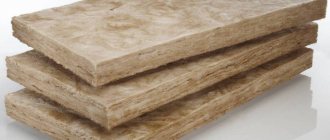Properties of mineral wool in slabs as insulation
The thickness of the insulation depends on the base
Mineral wool is a stone-based insulation material that allows you to create thermal insulation for a structure. Lava rocks are heated and melted to make the material. Binders are added to shape and tighten the fibers. The final product retains the properties of basalt:
- Thermal conductivity from 0.03 to 0.04 W/m – the ability of insulation to maintain temperature. The indicator of mineral material with a thickness of 10 cm is comparable to 25 cm of timber, 200 cm of sand-lime brick and 117 cm of ceramic.
- Density - the indicator ensures the use of slab isolate and is on average 60-80 kg/m3. To install a pitched roof, you will need light slabs of 30-50 kg/m3, for a flat roof - from 100 kg/m3. For industrial purposes, models from 160 kg/m3 are used, which do not deform under the influence of external load.
- Fire resistance class NG. Basalt fibers do not ignite, do not spread fire, and can heat up to +750 degrees. Non-flammable modifications heat up to 1000 degrees for 2 hours.
- Moisture absorption. Minplates have an indicator of 1-2%, i.e. do not absorb condensation and precipitation.
The thermal conductivity index depends on the direction of the fibers. The best option is a chaotic location.
Advantages and disadvantages
Advantages of basalt wool
Products are supplied wound in a roll and then cut. Mineral wool is suitable for all types of insulation work due to the advantages:
- sound insulation - can be installed in houses near the roadway and production workshops;
- absence of cold bridges - sheets do not shrink at the joints;
- special structure - the fibers are arranged in a chaotic direction or intertwined, which prevents warm air from leaving the room;
- ease of installation - the slabs can be easily cut with a knife or hacksaw on site;
- wear resistance - the insulation retains its properties for 20-70 years;
- environmental friendliness - made on the basis of natural basalt rocks.
The disadvantages of mini-slabs include the difficulty of installation due to high vapor permeability.
general information
Mineral wool is produced using a technology that has already become a classic. This is the use of raw materials from rocks such as basalt, which are processed at high temperatures.
After melting, the result is combined with special chemicals to produce stone wool fibers. From the fibers themselves, cotton wool is already created as a full-fledged building material.
As you understand, this initial structure affects the properties of mineral wool. So, its thickness must be quite impressive so that the fibers can stick to each other. Also, cotton wool has a high density, does not react to many external influences, etc.
Moreover, the density of mineral wool is really high. Especially if slab insulation is taken into account. Here the density of the slab can be equal to the density of the foam. And at the same time, the thickness of the material will have little effect on its density, as well as its size. But this factor still needs to be taken into account.
This insulation is almost ideal for finishing walls and insulating the walls of an apartment from the inside, since its installation is carried out using the simplest technology. If desired, it can be combined with other materials. For example, laying drywall, siding, etc. over mineral wool.
Sizes and shape of mineral wool
Mineral wool insulation is produced in two main types or forms. Vata is found in:
- Rolls;
- Slabs.
Cotton wool in rolls are long strips of mineral insulation that are rolled into a small roll. Its length when unfolded can reach up to 7-10 meters, but its width rarely exceeds 1.2 m.
Mineral wool slabs
The thickness of the roll is a maximum of 50 millimeters. This size of the workpiece allows you to safely transport rolls of insulation without spending too much space on its placement.
Cotton wool in rolls is most often cheaper. It absorbs moisture faster, can settle over time, and its installation on walls is not carried out using the easiest technology. The density of wool in rolls is also, as a rule, lower than the density of insulation in slabs.
To secure the roll and insulation to protect the walls of the house efficiently, you will have to seriously tinker. After all, first you need to spread it (and doing this on a vertical wall is not so easy), and then also fix it. It seems impossible to cope with such work alone.
And the size of the roll, or rather its length, must also be taken into account. If it has a length of more than 6 meters, then using the material in this form for wall decoration will simply be unproductive (it will have to be additionally cut).
But mineral wool in slabs was specially created for finishing walls and other vertical structures.
The size of the slab is on average 1000×1200 mm. Its width can vary, but a length of 1200 mm is considered almost a standard.
The thickness of the slab may vary depending on its purpose. Thus, the thickness of the slab for floor insulation can be only 30-40 mm. But the thickness of the facade slab or insulation for thermal insulation of a flat roof can reach up to 80-100 mm or even higher.
The size of liquid thermal insulation boards allows them to be conveniently laid anywhere. You can even install them yourself, and you only need a few tools from the available tools.
The density of the insulation in the slabs also changes significantly. Insulation for roof slopes has an extremely low density. For this type of slab, this parameter is a real necessity.
Plates for finishing walls or flat roofs, on the contrary, have an increased density. You can actually walk on them with a load, without fear that the mineral wool will bend or become deformed.
Properties of mineral wool
Let us turn directly to the properties of mineral wool, for which it is so valued in the construction industry. And by the way, it has just a huge number of positive properties.
Mineral wool in rolls: types and sizes
The modern market offers a wide variety of all kinds of innovative thermal insulation materials. This includes liquid-ceramic heat insulator, polyurethane foam, and silica mats. However, mineral wool is still the most popular of them.
Mineral wool is characterized by a low thermal conductivity coefficient, a wide temperature range, high fire safety and absolute environmental friendliness.
Rock wool rolls are usually used to insulate horizontal surfaces. This installation requires careful handling and avoidance of too much stress on the surface. Rolls are used to insulate floors between floors, floors, attics, and roofs with a slight slope. They are also used to insulate pipes, fireplace covers and home stoves.
Roll dimensions (width, thickness, length in mm):
- Ursa M-11 – 1150 by 53 by 9000;
- Isover Classic – 1220 by 50 by 8200;
- Isover Sauna – 1200 to 50 to 8200;
- Heat Knauf Dacha - 1220 by 50 by 7380.
Bulk mineral wool is inconvenient to roll, so its thickness usually does not exceed 50 mm. Mineral wool in rolls can be used to insulate large areas where the surface is subject to significant load. For laying rolls, logs, rafters and other building elements are usually used.
Why do you need mineral wool sizes?
Mineral wool insulation has a lot of advantages, which makes it possible to choose it as the main material for constructing a thermal insulation system. To accurately calculate the required amount of material, you should know the dimensions of the mineral wool slabs that you decide to use in your work. If when purchasing a thermal insulation material it is necessary to take into account the cubic capacity, then in a number of works it is necessary to take into account the dimensions of the mineral wool.
In what cases are the dimensions of mineral wool taken into account?
When installing a thermal insulation system with the creation of a frame, pre-specified dimensions of mineral wool slabs, which are optimally suited for thermal protection in a given region, allow preparatory work to be carried out in advance, which makes it possible to reduce the time for creating thermal protection. This could be:
- for floor insulation, since insulation boards should be laid tightly between the joists;
- when insulating an attic space, since the size of the mineral wool affects the size of the cells or the pitch of the logs between which the insulation is tightly laid.
For exterior work, a frame can also be pre-created, into which slabs of heat-insulating material are then carefully placed between profiles or wooden slats.
There are no words, the high performance characteristics of slabs made of mineral raw materials, their elasticity and appropriate density, allow, if necessary, to cut off a piece in order to carefully place it in the right place. But don’t do this during the entire installation process. And no one needs extra joints.
What sizes are mineral wool slabs?
It is generally accepted that the standard sizes of mineral wool, which are the most popular among buyers, are 1000 mm x 500 mm. Since the choice of insulation thickness depends on the structural element being insulated and the region of residence, it is determined in each specific case. The thickness of the thermal insulation material can, however, affect its dimensions, since slabs with a thickness of 150 - 200 mm are also available in larger widths - up to 600 mm.
In principle, each manufacturer produces its own products, the sizes of which may differ from the usual ones. For example, Izover suggests:
- the size of the Izover frame P-32 mini-plate is 1170 by 610 mm (thickness varies from 40 to 150 mm);
- Isover frame P-34, the thickness of which varies from 40 to 200 mm, has dimensions of 1170 by 610 or 565 mm;
- the slab used for the “floating floor” system, with a tongue-and-groove edge, thickness from 20 to 50 mm, has different dimensions - 1380 by 1190 mm;
- Izover rigid slab for a flat roof, 30 mm thick, has dimensions of 1550 by 1180 mm.
Advantages and disadvantages
Now we can create a complete list of pros and cons to structure the knowledge presented.
Exterior finishing of the house facade with mineral wool slabs
Main advantages:
- High density;
- Ability to install in a short time;
- Non-flammability;
- Hydrophobicity;
- Environmental friendliness as when insulating a hangar using polyurethane foam;
- Not gnawed by rodents, insects, etc.;
- Vapor permeability.
We have already noted the main disadvantages - the high price. You will also have to pay more for installing mineral wool. The installation process, although simple, is quite labor-intensive in terms of mechanical work.
Mineral wool differences
As we have already said, there are three types of mineral wool insulation. Each of them is made from different raw materials and has its own properties.
Glass wool
A material consisting of molten glass cullet, dolomite, sand, soda or limestone.
Advantages:
- Breathability.
- Fire resistance.
- Elasticity, vibration resistance.
- Withstands low temperatures.
- Lower cost than other mineral wool.
Minuses:
- Short shelf life - 5-10 years.
- Shrinkage 80%.
- Strongly absorbs moisture.
- If it comes into contact with the skin, it causes itching or even an allergic reaction.
As for the scope of application, it is usually mineral wool for insulating walls inside the house.
Slag
Produced from metallurgical waste. Inferior in characteristics to other types of insulation.
- Does not provide adequate sound insulation.
- Does not withstand strong heat. It does not burn, but it sinteres and loses its thermal insulation qualities.
- Does not tolerate temperature changes.
- Protective clothing and a respirator for installation are also required.
- It is impossible to insulate damp rooms with metal fasteners, since under the influence of moist air, slag will promote corrosion.
- High hygroscopicity.
Plus, such a layer in the wall does not attract rodents and insects. Most often used on dry surfaces of temporary buildings or non-residential buildings.
Stone
The most expensive material. It is usually chosen for exterior work in private houses, including frame wooden houses. Rocks are used in production. Thanks to this, the final product has many advantages:
- High density and therefore strength.
- Fire resistance. Does not ignite at any temperature.
- Minimum shrinkage (5%).
- Long service life (up to 50 years).
- Provides excellent sound insulation.
- Almost does not break during operation, which happens with other types of products.
- Vapor permeability. The fibers repel moisture.
The downside is the high cost. Despite all the advantages, it is not always rational to insulate with these slabs.
Types depending on material of manufacture
The 3 options for thermal insulation slabs made of mineral wool are glass wool, stone wool and slag wool.
These varieties have a specific mineral wool width, fiber length and technological parameters that determine their popularity for use in a particular area.
Slag
Slag wool is produced from electric blast furnace slag and has a fiber size of 4 to 12 microns and a length of 16 mm. Thermal conductivity is 0.48 W/mK with increased hygroscopicity. Mineral wool dimensions - 500x1000x50 mm. This modification is hydrophobic and, more than others, has a predisposition to humidity, which does not make it possible to use it on external roof insulation, and its low level of fire safety precludes use in attic spaces.
Another disadvantage is that the fibers are quite brittle, and it is possible to work with such material only with gloves. Despite all this, given the good flexibility and uniform thickness, working with such material is quite convenient. In addition, slag wool is not heavy; even a decent amount of mats does not create a load on the roofing system. It has a very light structural structure, thermal conductivity 0.048 W/mK.
Due to its texture, it has high vapor permeability and hygroscopicity, and therefore, with this type, it is necessary to use waterproofing.
Glass wool
Glass wool is a budget building material for thermal insulation. At the same time, it has very good density and elasticity, with a thermal conductivity coefficient of 0.050 W/mK. It is made from the same consumable materials as ordinary glass - sand, soda, dolomite and limestone rocks. Fiber size up to 15 microns. The dimensions of mineral wool insulation in slabs are 1250x600x50 mm.
Permissible temperature +450C. The main advantage is the relatively low price. The disadvantages are low performance characteristics and a high risk for the human respiratory organs and skin, which forces you to quickly perform insulation work, with dense protection of the laid layer with surface material, while the worker must use special clothing, respirators and goggles when working.
Main categories
Wall insulation is divided into 2 groups:
- For internal insulation.
- For external insulation.
These categories differ from each other only in their ability to pass steam or retain it. Mineral wool, packaged in slabs, mats, rolls, is easy to use, easy to cut and fills the most inaccessible corners, leaving virtually no waste after cutting.
TechnoNIKOL
- Technofas. Available in the form of a slab measuring 600*1200*50/100 with a density of 145 kg per 1 m3.
- Technoven Standard. Plate. Dimensions 600*1200*50/100, density 80.
Knauf
- Insulation FKD. Slab (600*1200* 20-160, density 140 -150.
- Insulation FKL, plate. 200*1000*20-200, density 85.
- Insulation FKD-S, plate 600*1200*60-180, density 140-160.
- Insulation HTB, plate 1000*500*20-180, density 35-150.
Rockwool
- Fasrock, roll 1000*600*100, density 135.
- Wentirock max, roll 1000*600*50, density 50-90.
- Panelrock, plate 1000*600*50-100, density 65.
ATTENTION! The fine-fiber structure of mineral wool contains formaldehyde, and therefore is classified as a carcinogenic building material. For safe installation, it is necessary to have special protection for the worker performing insulation or insulation. To prevent fibers from scattering throughout the room, the pressed slabs should be protected with membranes. And only after that begin finishing work.
Recommendations for thickness and density of mineral wool
Taking into account the climatic characteristics of the region is crucial when choosing the size of insulation. For the external walls of houses located in areas of temperate continental climate (Moscow, Leningrad, Volgograd and other regions), it is recommended to choose slabs with a thickness of 80-100 mm. As the region moves away from a given area (continental, sharply continental, monsoon, maritime climate; subarctic, arctic zones), the thickness increases by about 10%. For example, for the Murmansk region it is advisable to take mineral wool with a thickness of 150 mm for external walls, and for Tobolsk the correct range will be from 90 to 110 mm.
Insulation with a density of up to 40 kg/cu.m. m is used only in unloaded horizontal surfaces, so it is better to ignore them. This type of wool is produced in rolls, rolled onto sheathed interfloor partitions, floors, etc. For insulation of external walls of non-residential or industrial premises, the figure varies from 50 to 75 kg/cu.m. m. If the user makes a ventilated facade, the slabs should be even denser - up to 110 kg/cu.m. m. Otherwise, the figure can reach 130-140 kg/cubic meter. m, but on the condition that the walls will be plastered later. The first option involves subsequent finishing with siding or a similar method of finishing work in order to extend the service life.
Structures insulated with basalt slabs
The use of basalt wool is quite wide. Manufacturers produce basalt wool for insulating various surfaces. Let's consider the brands, sizes and density of basalt wool from leading manufacturers for insulating facades, walls, partitions, floors and roofs.
Insulation of facades with basalt wool
Stone mineral wool is used to insulate facades. This can be a layer of thermal insulation for “wet” and ventilated facades. Thermal insulation of facades with cotton wool is the most popular among the options for insulating modern buildings for any purpose. This type of thermal insulation lasts a very long time - more than 40 years.
ManufacturerBrandTypeDimensions, mmDensity, kg/m3
| TechnoNikol | TECHNOFAS | plate | 600×1200, 50 (100) | 145 |
| TECHNOVENT STANDARD | 600×1200, 50 (100) | 80 | ||
| Knauf | Insulation FKD | plate | 600×1200, 20-160 | 140-150 |
| Insulation FKD-S | plate | 600×1200, 60-180 | 140-160 | |
| Insulation FKL | plate | 200×1000, 20-200 | 85 | |
| Insulation HTB | plate | 1000×500, 20-180 | 35-150 | |
| Rockwool | Fasrock | roll | 1000×600Х100 | 135 |
| Panelrock | plate | 1000x600x50-100 | 65 | |
| Wentirock max | roll | 1000x600x50 | 50-90 |
Popular materials from TechnoNikol: TECHNOFAS and TECHNOVENT STANDARD; Rockwool companies: Fasrock, Wentirock max and Panelrock; and Knauf companies: Insulation FKD, Insulation HTB and others.
Basalt wool for insulation of partitions and walls
ManufacturerBrandTypeDimensions, mmDensity, kg/m3
| TechnoNikol | Mat TechnoNIKOL regular | roll | 1000x4000, 50 (100) | up to 30 |
| ROCKLIGHT | plate | 600×1200, 50 (100) | 30 | |
| TECHNOLITE EXTRA | plate | 600×1200, 50 (100) | 30 | |
| TECHNOLITE OPTIMA | plate | 600×1200, 50 (100) | 35 | |
| TECHNOBLOCK STANDARD | plate | 600×1200, 50 (100) | 45 | |
| Knauf | Insulation LMF Alur | roll | 1000×2500, 20-100 | 35-90 |
| Rockwool | Domrock | roll | 4750×1000, 200 | 20 |
| Superrock | roll | 1000x600x50 | 35 |
Basalt wool slabs are used for internal and external wall insulation. The material provides good thermal protection of the room from the inside, and also provides excellent sound insulation. Mineral wool slabs are suitable for insulating internal partitions against noise in offices and residential premises. But given that low-density basalt wool is used for these purposes, it is more rational to use the material in rolls. This simplifies the installation work. For example, the manufacturer Knauf produces Insulation LMF Alur brand mats for insulating partitions, and the Rockwool company produces Domrock and Superrock rolls.
Thermal insulation of floors with basalt wool
ManufacturerBrandTypeDimensions, mmDensity, kg/m3
| TechnoNikol | ROCKLIGHT | plate | 600×1200, 50 (100) | 30 |
| Heatroll | roll | 4000Х1000, 50 (100) | 30 | |
| Knauf | Insulation LMF Alur | roll | 1000×2500, 20-100 | 35-90 |
| Insulation PVT | plate | 600×1000, 20-120 | 175 | |
| Rockwool | Rockmin Plus | plate | 1000x600x50 | 31 |
| Rockton | plate | 1000x600x50-120 | 50 | |
| Superrock | roll | 1000x600x50 | 35 |
Basalt wool is an indispensable material for thermal insulation of floors. Basalt insulation slabs are used for flooring. They are characterized by high rigidity and perform sound and heat insulation functions. The material is laid under slabs, joists and under screed. In addition, basalt wool slabs are used in such a popular system as the “floating floor”.
Insulation of flat and pitched roofs with basalt wool
Stone wool in the form of slabs is widely used for roof insulation. On the modern construction market there are special slabs used exclusively for thermal insulation of roofs.
ManufacturerBrandTypeDimensions, mmDensity, kg/m3
| TechnoNikol | ROCKLIGHT | plate | 600×1200, 50 (100) | 30 |
| TECHNOLITE EXTRA | plate | 600×1200, 50 (100) | 30 | |
| TECHNOLITE OPTIMA | plate | 600×1200, 50 (100) | 35 | |
| TECHNOBLOCK STANDARD | plate | 600×1200, 50 (100) | 45 | |
| Knauf | Insulation DDP | plate | 600×1200, 20-180 | 150-200 |
| Insulation DDP-K | plate | 600×1200, 40-160 | 105-110 | |
| Rockwool | Dachrock max | plate | 2000×1200, 40-200 | 130-210 |
| Domrock | roll | 4750×1000, 200 | 20 | |
| Megarock | roll | 3000(6000)x1000x200(100) | 28 | |
| Monrock | plate | 2000x1200x50-200 | 115-200 | |
| Rockmin Plus | plate | 1000x600x50 | 31 | |
| Rockton | plate | 1000x600x50-120 | 50 | |
| Superrock | roll | 1000x600x50 | 35 |
Thickness of mineral wool for ceiling insulation. Choice of insulation
Before purchasing thermal insulation material, it is necessary to take into account several quality characteristics, including:
- degree of vapor permeability;
- weight;
- strength;
- flammability;
- price.
There are two types of ceilings:
- Made from concrete slabs. These products do not burn and have high load-bearing capacity. Concrete is considered to have partial vapor permeability. But for slabs this indicator is insignificant and therefore, when choosing which insulation is best for the ceiling, it is customary not to take it into account.
- Wooden. In private households, ceiling structures are often made of wood, which burns well and allows a little steam to pass through. If you block the air supply to the rafters, they will begin to rot over time. In addition, laying flammable insulation on a wooden surface is very dangerous.
One of the main parameters that influences which insulation to choose for the ceiling is where it is installed. This is explained by the fact that the ceiling can be thermally insulated both from the side of the unheated attic space and from the inside of the building.
For the home craftsman, the easiest way to do insulation is in the attic, because in this case there is no need to hem the ceiling from below. In addition, in the case of external installation, you will not have to decide what thickness of insulation is best to use, since there will be enough space in the attic. You can use both bulk material and in the form of slabs. You need to choose attic insulation based on your specific situation.
The situation is different with the installation of thermal insulation from inside the room. In private homes, you can’t always find really high ceilings, which means you will need to take every centimeter away from the living space.
As practice shows, property owners rarely decide to lower the ceiling surface by more than 15 centimeters. Accordingly, it is better to use insulation that is lightweight, but at the same time durable and with a low degree of thermal conductivity.
To find out which insulation is better for the ceiling under certain operating conditions, you should analyze information about the materials most often used in construction.
Other important markings
In order to understand in what form the insulation will be presented, you should consider the additional markings on the packaging. Namely:
- P-75. The number means density; the less dense the mineral wool, the more convenient it is to roll it. This is exactly the case. Such types are used for walls that will not take on a load-bearing load.
- P-125. These are already slabs, they are used for the ceiling and floor. It has increased sound insulation properties.
- PPZh-175. In addition to the fact that the density of this stone wool is 175 kg/m³, it also has increased rigidity, as indicated by the “F” marking.
- PPZh-200. The densest mineral wool, which is also fire resistant.
Mats are convenient to use on the floor
How to insulate aerated concrete, mineral wool or polystyrene foam
Mineral (stone) wool and polystyrene foam are the main insulation materials for aerated concrete houses. Low-density aerated concrete (D200) and sprayed polyurethane foam are used much less frequently.
Insulation should be carried out only from the outside of the building so that the dew point is closer to the outer layer of the wall.
Dew point is a place in the wall with zero temperature. In this zone, a zone of increased condensation (moisture) is formed; the wall in this place constantly freezes and thaws.
If we compare polystyrene foam and mineral wool, then wool is a more expensive and correct solution for aerated concrete walls; it’s all about vapor permeability. Cotton wool has excellent vapor permeability, which ensures that moisture is removed from the wall to the outside of the house. Thus, the interior will be drier and more comfortable. The thickness of mineral wool insulation can be made to any thickness, but it is more economically feasible - from 100 mm.
Polystyrene foam does not allow steam to pass through well, trapping it in the wall and creating increased humidity in the house. Moreover, aerated concrete walls need to be insulated with foam plastic with a thickness of 100 mm or more in order to guarantee that the dew point will shift from the wall to the insulation. Otherwise, at the boundary between the foam plastic and the wall, moisture will constantly freeze and thaw, reducing the service life of the wall.
In general, we recommend using mineral wool or foam plastic with a thickness of 100 mm or more, but it is better to give preference to mineral wool.
Advice from experts
Finding out the size of stone wool is often necessary in order to calculate how much material is needed for insulation. Don’t think that it’s too easy; they often buy too much or, worse, too little material. To avoid making mistakes in calculating quantities, you need to consider the following points:
- Almost every package indicates how much area one “portion” of mineral wool can cover. This information will help determine exactly how many packages are needed.
- Do not forget that stone and any other mineral wool has properties such as shrinkage - it is better to purchase it in excess. Therefore, about 15% should be added to the results obtained. This will help avoid the formation of cracks.
- In order to minimize the consumption of insulation and waste from it, it is necessary to calculate the optimal distance at the stage of construction or installation of the sheathing, often 50-60 cm.
- It is imperative to double-check the size of the roll or sheet of insulation, since even from the same manufacturer they may differ. As well as the area of the roll.
In general, to calculate the required amount of stone wool you need:
- Determine the insulated area. To do this, multiply the length by the width. If the area is not of a standard shape, then it must be divided into its component parts.
- Determining the perimeter of the house if everything is insulated - walls, ceilings, floors. Multiply the perimeter by the height and by the number of floors, if there are several.
- If you also need to insulate the roof, then calculate its area.
- All that remains is to add up the resulting dimensions and do not forget to add about 15% for trimming the seal.
Important! Manufacturers do not take the sizes of rolls and mats from the ceiling; they are determined by building codes that help standardize the process of constructing house insulation.
Mineral wool can be of different thicknesses from the same manufacturer
Preparatory part
Before you insulate the floors in the attic of your home, you need to be well prepared.
This includes:
- selection of wool and related materials;
- calculation of the required amount of material;
Selection of mineral wool
Stone or mineral wool is the name of a whole direction, in which there are dozens of different models. Based on the name, this includes all soft insulation materials made from rocks; the most famous option is basalt wool.
A number of sources include glass wool and slag wool here. In the first case, glass is used as the basis, and slag wool is made from blast furnace slag (a by-product of blast furnace production).
All materials are good, but which one is better is a moot point. I’ll say right away that if you take material from a well-promoted brand, there is not much difference in quality.
Mineral wool on any base is suitable for a cold attic
It is much more important to choose the type of material.
There are 2 types of such insulation:
- Soft mats , which are sold rolled into rolls.
- Dense slabs.
Theoretically, insulating the ceiling from the cold attic side can be done using both options, but from experience, it is better to give preference to dense slabs.
The price of the slabs is slightly higher, but this material does not shrink over time, plus, when wet, some models of slabs can be dried without loss of volume and quality.
As for soft mats, here you are buying a “pig in a poke”; well-known manufacturers make good products, but it is not a fact that you will not buy a fake.
This is interesting: Do-it-yourself insulation of attic floors
Such mats are inexpensive, but in an attic they lose volume in a couple of years.
It is better to insulate the ceiling of a cold attic using slabs
Related materials
This is the case with related materials. Any cotton wool is afraid of moisture; to protect it, a vapor barrier membrane is needed.
It is a fabric that allows steam to pass through only in one direction; neither steam nor moisture passes through from the other side.
Important! Steam moves from the room to the street or to the attic, so the membrane is laid with a vapor-permeable side towards the room, i.e. down.
Vapor barrier allows steam and moisture to pass through only in one direction
Advice! how to insulate a bathhouse ceiling from the attic side
Material calculation
To calculate the amount of wool, you need the area of the attic and the thickness of the insulation:
- With the area of the attic floor, everything is simple - the length is multiplied by the width. Plus 5% for shrinkage and trimming.
- The thickness of the material depends on the climate zone. In central Russia, to insulate an attic floor with mineral wool, the thickness of the slabs is 100 mm, the mats are taken 150 mm. Accordingly, the further north, the thicker the layer.
Advice! If you expect to lay slabs, for example, to a thickness of 100 mm, then it is better to take 2 slabs 50 mm thick and lay them offset. This way the joints overlap and there will be no cold bridges.
It is advisable to do insulation of the attic floor with mineral wool in several layers
Which wool is better to choose for thermal insulation of roofs, floors and walls?
The most important factor when selecting building materials is the thickness of the mini-slabs. It depends on the following conditions:
- Dew point position;
- atmospheric climatic region of location;
- roofing system design;
- ability to withstand load;
- thermal conductivity of a type of insulating material;
- the form in which it is made.
Additional Information! The width of the mini slabs for roofing is available in a variety of modifications. In order to avoid complicated types of calculations, it is better to choose insulation parameters that are recommended for different climatic regions. So, for example, in the southern regions, mineral wool sizes range from 120 to 180 mm, then in the central regions - 180-240 mm, and in the northern regions up to 360 mm with an average thermal resistance of the heat insulator - 0.04 W/mK.
Errors in installing mineral wool slabs
- Lack of surface preparation. It should be smooth, clean and treated with an antiseptic (if it is wood).
- Carrying out work during rainfall or leaving finished work unprotected from rain.
- Insufficient application of glue. It is correct when it is distributed over the entire surface, including the perimeter. The most suitable glue is polyurethane foam or dry mixture. The first product is easier and faster to work with, but it is a little more expensive. Both products are resistant to external influences and guarantee good adhesion.
- Unfilled seams between insulation parts. They can only be closed with inserts made of the same material. The maximum gap is 2 mm.
- Intersection of slabs at window and door corners. There should be no joint in these places.
- Lack of mechanical fastenings. Anchors and dowels are used as additional connections for heavy sheets. The optimal quantity is 3-4 pieces per piece (two in the corners, 1 or 2 in the center).
- Smooth mounting, joint to joint. Craftsmen advise installing elements in a checkerboard pattern - this makes it easier to avoid gaps in the structure.
These are the main mistakes that people make when doing thermal insulation at home on their own.
